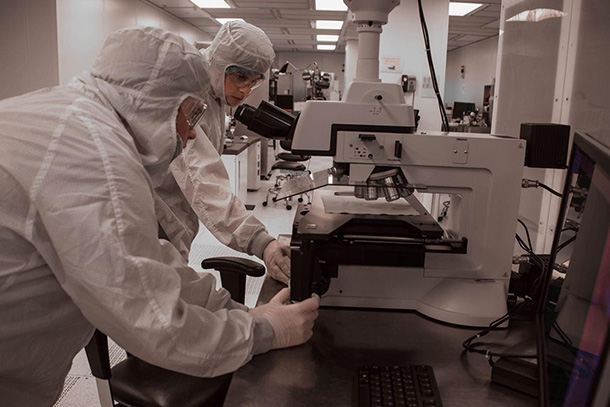
The Center for Nanotechnology Education and Utilization (CNEU) was created by Penn State in 1998 to address the need for skilled workers in Pennsylvania's semiconductor industry. The center continues to prepare workers across the full range of micro- and nanofabrication applications. Credit: CNEU/Penn State.
Q&A with Awadelkarim: The CHIPS Act and strengthening the U.S. workforce
August 12, 2022
By Adrienne Berard
This article originally appeared on Penn State News. Osama Awadelkarim, UNESCO Chair and professor of engineering science and mechanics, was featured.
President Joe Biden recently signed into law the CHIPS and Science Act, a $280 billion package to support domestic semiconductor manufacturing capabilities and increase research and development in the sector.
Awadelkarim is an expert on semiconductor fabrication and microelectronics workforce development. He testified before Congress regarding the CHIPS Act and the need to strengthen the pipeline from education to industry. This Q&A has been adapted from those remarks.
What are semiconductors and why should the average person care about them?
With the advent of the internet of things and artificial intelligence, semiconductors in the form of integrated circuits (ICs), or “chips,” have become an integral part of our technology-driven world today. Almost all products that we use, from microwave ovens to mobile phones to advanced computers, utilize ICs in one way or another. Hence, the need for chips has risen sharply while the chip supply worldwide has fallen significantly short of the demand.
Why would the U.S. want to invest taxpayer dollars in the semiconductor industry?
Semiconductor products are very critical to our economic and national security and are ranked as the fifth largest U.S. export sector, providing roughly 250,000 U.S. jobs directly and over a million indirectly. However, at the present time, the U.S. share of chip supply to the world is only about 10%. That means we are relying on other nations to produce a product that is vital to our economic and national security.
The U.S. invested heavily in chipmaking in the 1980s and '90s. What has changed since then?
Semiconductor nanomanufacturing has undergone major technological advances and, currently, state-of-the-art nanofabrication facilities, or “nano-fabs,” are used to manufacture chips with nanoscale devices in high volumes. For the U.S. to restore world leadership in chipmaking, it is imperative to increase domestic advanced semiconductor nanomanufacturing capacity and capability. An important aspect to capacity and capability building is developing the necessary nanomanufacturing workforce. Nanofabrication opens the door to super high-density microprocessors and memory chips, as well as enables future assembly of chips atom-by-atom. We need a workforce trained to work with that kind of advanced technology.
Give me an example of what that training would look like.
The Center for Nanotechnology Education and Utilization (CNEU) was created by Penn State in 1998 to address the needs of Pennsylvania's semiconductor industry for skilled workers and is still dedicated to preparing workers across the full range of micro- and nanofabrication applications.
We have a “resource-sharing” approach, whereby our nanofabrication infrastructure is accessible to students and industry partners. This approach is a proven, working model for accomplishing the needed nanotechnology workforce training crucial to U.S. competitiveness. The approach provides the means for workforce training institutions to have access to the expertise and facilities required to deliver the broad nanotechnology education needed to empower the U.S. and its workforce and give them the resiliency to compete in today’s fast-moving world.
Where do you see industry contributing to this effort to educate the future workforce?
Industry plays a very important role in advanced manufacturing and technology education for the very basic reason that industry informs academicians whether what is being taught to students is meaningful, or not, to companies. Industry input to courses and curriculum has been the principal force in shaping our various education and training programs.
What are your thoughts on the CHIPS Act and what it can do for the country?
During this challenging time for our nation’s semiconductor industry, there is a need to be effective, efficient and outcome-driven. Such challenges require federal government intervention and action to address the semiconductor shortage and grow the semiconductor manufacturing workforce.



